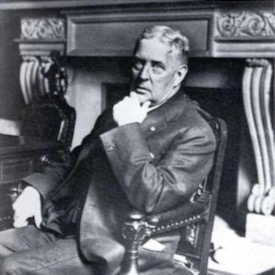Edmund Charles Tarbell was born in West Groton, Massachusetts in April 1862 in the Asa Tarbell House sited beside the Squannacook River. An American impressionist painter, Tarbell was a leading member of the Boston School of painters and the Ten American Painters. His paintings hang in the Boston Museum of Fine Arts, Metropolitan Museum of Art, the Currier Museum and numerous other collections.
Ned, as he was nicknamed, was raised by his paternal grandparents after the death of his father in 1863 from typhoid fever and his mother’s subsequent remarriage. As a young boy, Tarbell began his art lessons at the Massachusetts Normal Art School and in 1889 entered the School of the Museum of Fine Arts in Boston, studying under Otto Grundmann.
Encouraged to further his art study in Paris, France—then the center of the art world—Tarbell enrolled in the Académie Julian in 1883. There he was exposed to intensive academic training and the old masters at the Louvre, along with the impressionist movement. Both influenced his future work when he returned to Boston and began his career as an instructor, illustrator, and portrait painter three years later.
In 1888, Tarbell married Emeline Arnold Souther, the daughter of a prominent Dorchester family and fellow art student. His wife, four children, and grandchildren were frequent models for his paintings. Living in various Boston neighborhoods, including Ashmont in Dorchester, Commonwealth Avenue, and The Fens, Tarbell taught at the Museum School. In 1905, the family bought a summer house in New Castle, New Hampshire, an island on the coast, where they would eventually retire. His studio perched on the banks of the Piscataqua River, with views of the shipping channels, sailboats, ocean, and gardens.
A popular instructor at the school, Tarbell provided his students with a solid academic art foundation, much like his early training in Europe. His influence on his students, who included Bertha Coolidge, Marie Danforth Page, and Lillian Westcott Hale, was extensive, earning them the name of “The Tarbellites”.
In 1912, as a result of an upheaval at the Museum School, Tarbell resigned his position, along with fellow teacher and friend Frank W. Benson. The two, with the financial support of Lilla Cabot Perry, an affluent painter and Boston Brahmin, founded the Guild of Boston Artists in 1914. This organization served to encourage art and artists within the Boston Community. Tarbell served as the first President through 1924.
He would eventually return to the Museum School in 1926 after six years in the position as principal at the Corcoran Gallery of Art in Washington, D.C. Appointed in 1925 as Chairman of the Advisory Council, Tarbell oversaw the construction of the Museum School’s new building designed by Guy Lowell.
Tarbell’s 1891 painting, “The Orchard,” firmly established his reputation as an artist. His impressionistic, brightly-colored figures within the landscape drew a wide audience. His later works show influences of the 17th Century Dutch painter Johannes Vermeer. Many famous figures, including Presidents Woodrow Wilson, Calvin Coolidge, and Herbert Hoover, along with industrialist Henry Clay Frick, were painted by Tarbell.
Tarbell enhanced America’s world of art, drawing admiration and appreciation from Europe and his American countryman. Some of his paintings can be seen nearby at the Groton Public Library and the Currier Museum in Manchester, New Hampshire.
Sources: The Museum of Fine Arts, Wikipedia

